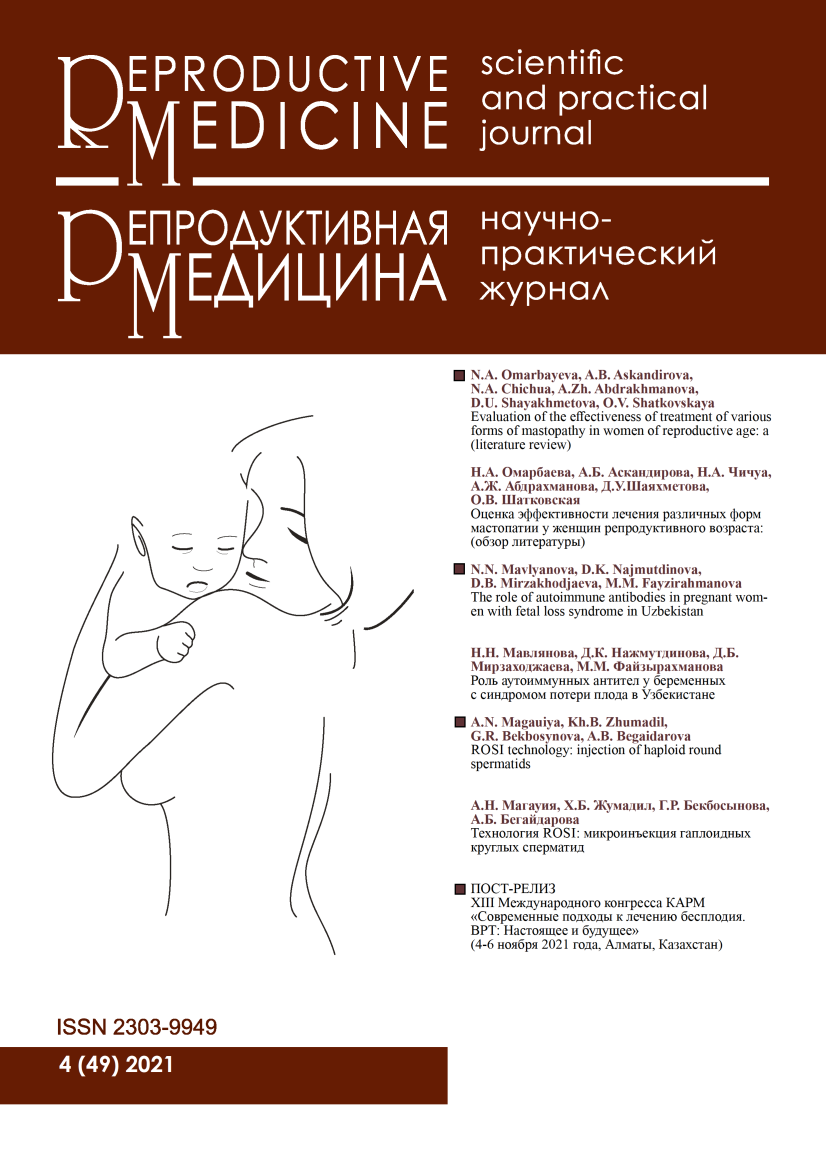The role of autoimmune antibodies in pregnant women with fetal loss syndrome in Uzbekistan
DOI:
https://doi.org/10.37800/RM.4.2021.36-42Keywords:
pregnancy, fetal loss syndrome, autoantibodies to native DNAAbstract
Relevance: Fetal growth restriction syndrome (FGRS) is one of the most important causes of perinatal morbidity and mortality, the risk of sudden infant mortality. In this regard, the study of the role of antinuclear antibodies to native class G DNA in the blood serum of pregnant women with SAD will contribute to the disclosure of new pathogenetic aspects of the development of this pathology. The article presents the results of a study of the detectability of the levels of autoantibodies to native DNA in the blood serum of pregnant women with SORP.
The purpose of the research was to assess the levels of autoantibodies to native class G DNA in blood serum to identify the role of autoimmune antibodies in pregnant women with fetal loss syndrome.
Methods: 71 pregnant women aged 19 to 41 years were examined. The diagnosis of SORP was established based on clinical, laboratory, and functional studies. The level of autoantibodies of class G to native single-stranded and double-stranded DNA in blood serum was determined by the method of solid-phase ELISA study.
Results: The results of the study showed that in pregnant women with a severe degree of SORP, there was an increase in the concentration of autoantibodies to native double-stranded DNA by 54.6 times, and the level of antibodies to single-stranded DNA - 9.5 times compared with the control group of pregnant women without SORP.
Conclusions: The results obtained indicate the development of an associated autoimmune process in pregnant women with fetal growth restriction syndrome. At the same time, an increase in the concentration of AAT class G to double-stranded (dsDNA) and single-stranded (ssDNA) DNA indicates the activation of autoantibodies. In our opinion, the data obtained have diagnostic and prognostic value in the clinical course of fetal growth restriction syndrome. Determination of the AAT class G titer will facilitate further selection of adequate treatment.
References
Ярыгина Т.А., Андреева Е.Н., Одегова Н.О., Шелестова М.Л., Батаева Р.С. Анализ группы риска по задержке роста плода при проведении комбинированного скрининга I триместра беременности // Ультразвуковая и функциональная диагностика. – 2016. – №2 (приложение: Тезисы VII Съезда специалистов ультразвуковой диагностики Сибири, 20-22 апреля 2016 года, Барнаул). – C. 118-119 [Yarygina T.A., Andreeva E.N., Odegova N.O., Shelestova M.L., Bataeva R.S. Analiz gruppy riska po zaderzhke rosta ploda pri provedenii kombinirovannogo skrininga I trimestra beremennosti // Ul'trazvukovaya i funkcional'naya diagnostika. – 2016. – №2 (prilozhenie: Tezisy VII S"ezda specialistov ul'trazvukovoj diagnostiki Sibiri, 20-22 aprelya 2016 goda, Barnaul) (in Russ.)]. http://www.rasudm.org/files/USFD_2016_2_085-120.pdf;
Алиева С.А. Взаимосвязь циркуляции антифосфолипидных антител и синдрома потери плода у пациенток с аутоиммунными заболеваниями щитовидной железы: автореф. дис. …канд. мед. наук: 14.01.01. – Москва, 2017. – С. 26 [Alieva S.A. Vzaimosvyaz' cirkulyacii antifosfolipidnyx antitel i sindroma poteri ploda u pacientok s autoimmunnymi zabolevaniyami shhitovidnoj zhelezy: avtoref. dis. …kand. med. nauk: 14.01.01. – Moskva, 2017. – S. 26 (in Russ.)]. https://dissov.msmsu.ru/Records/АЛИЕВА СВЕТЛАНА АЙДЕМИРОВНА/АВТОРЕФЕРАТ Алиева СА.pdf;
Алиева С.А., Хашаева Т.Х. Взаимосвязь циркуляции антифосфолипидных антител и аутоиммунных заболеваний щитовидной железы у пациенток с невынашиванием беременности // Акушерство, гинекология и репродукция. — 2014. — Т. 8, №4. – С. 57 [Alieva S.A., Xashaeva T.X. Vzaimosvyaz' cirkulyacii antifosfolipidnyx antitel i autoimmunnyx zabolevanij shhitovidnoj zhelezy u pacientok s nevynashivaniem beremennosti // Akusherstvo, ginekologiya i reprodukciya. — 2014. — T. 8, №4. – S. 57 (in Russ.)]. https://www.gynecology.su/jour/article/view/106/107;
Ахмед-заде В.А. Беременность и роды при антифосфолипидном синдроме: течение, перинатальные исходы // Медицинские новости. – 2011. – №5. – С. 81-85 [Axmed-zade V.A. Beremennost' i rody pri antifosfolipidnom sindrome: techenie, perinatal'nye isxody // Medicinskie novosti. – 2011. – №5. – S. 81-85. (in Russ.)]. http://www.mednovosti.by/journal.aspx?article=4998;
Еремина Е.Ю. Аутоиммунные заболевания печени и беременность // Практическая медицина. – 2011. – №6(54). – С. 12-18. [Eremina E.Yu. Autoimmunnye zabolevaniya pecheni i beremennost' // Prakticheskaya medicina. – 2011. – №6(54). – S. 12-18 (in Russ.)]. https://cyberleninka.ru/article/n/autoimmunnye-zabolevaniya-pecheni-i-beremennost/viewer;
Мамаджанова С. О., Мирзаева Ш. Р., Негматшаева Х. Н. Особенности клинического течения беременности у женщин с антифосфолипидным синдромом // Медицина и здравоохранение: материалы V Междунар. науч. конф. (г. Казань, май 2017 г.). — Казань: Бук, 2017. — С. 55-58 [Mamadzhanova S. O., Mirzaeva Sh. R., Negmatshaeva X. N. Osobennosti klinicheskogo techeniya beremennosti u zhenshhin s antifosfolipidnym sindromom // Medicina i zdravooxranenie: materialy V Mezhdunar. nauch. konf. (g. Kazan', maj 2017 g.). — Kazan': Buk, 2017. — S. 55-58 (in Russ.)]. https://moluch.ru/conf/med/archive/240/12038/;
Машкова Т.Я. Тромбофилия и неудачи ЭКО // Акушерство, гинекология и репродукция. – 2015. – Т. 9, №3. – С. 17-21 [Mashkova T.Ya. Trombofiliya i neudachi E'KO // Akusherstvo, ginekologiya i reprodukciya. – 2015. – T. 9, №3. – S. 17-21 (in Russ.)]. https://doi.org/10.17749/2313-7347.2015.9.3;
Платонова Н.М., Маколина Н.П., Рыбакова А.А., Трошина Е.А. Аутоиммунный тиреоидит и беременность: изменения в современных лечебно-диагностических парадигмах // Проблемы репродукции. – 2020. – №26(1). – С. 29-38 [Platonova N.M., Makolina N.P., Rybakova A.A., Troshina E.A. Autoimmunnyj tireoidit i beremennost': izmeneniya v sovremennyx lechebno-diagnosticheskix paradigmax // Problemy reprodukcii. – 2020. – №26(1). – S. 29-38 (in Russ.)]. https://doi.org/10.17116/repro20202601129;
Korevaar T.I., Muetzel R., Medici M., Chaker L., Jaddoe V.W., de Rijke Y.B., Steegers E.A., Visser T.J., White T., Tiemeier H., Peeters R.P. Association of maternal thyroid function during early pregnancy with offspring IQ and brain morphology in childhood: a population-based prospective cohort study // The Lancet Diabetes and Endocrinology. – 2016. – Vol. 4(1). – P. 35-43. https://doi.org/10.1016/S2213-8587(15)00327-7;
Alexander E., Pearce E., Brent G., Brown R., Chen H., Dosiou C., Grobman W., Laurberg P., Lazarus J., Mandel S., Peeters R., Sullivan S. 2017 Guidelines of the American Thyroid Association for the Diagnosis and Management of Thyroid Disease During Pregnancy and the Postpartum // Thyroid. – 2017. – Vol. 27(3). – P. 315-389. https://doi.org/10.1089/thy.2016.045;
Korevaar T.I., Schalekamp-Timmermans S., de Rijke Y.B., Visser W.E., Visser W., de Muinck Keizer-Schrama S.M., Hofman A., Ross H.A., Hooijkaas H., Tiemeier H., Bongers-Schokking J.J., Jaddoe V.W., Visser T.J., Steegers E.A., Medici M., Peeters R.P. Hypothyroxinemia and TPO-antibody positivity are risk factors for premature delivery: the generation R study // J. Clin. Endocrinol. Metabolism. – 2013. – Vol. 98. – P. 4382-4390. https://doi.org/10.1210/jc.2013-2855;
Teng W., Shan Z., Patil-Sisodia K., Cooper D.S. Hypothyroidism in pregnancy // The Lancet Diabetes and Endocrinology. – 2013. – Vol. 1(3). – P. 228-237. https://doi.org/10.1016/S2213-8587(13)70109-8.
Additional Files
Published
How to Cite
Issue
Section
License
The articles published in this Journal are licensed under the CC BY-NC-ND 4.0 (Creative Commons Attribution – Non-Commercial – No Derivatives 4.0 International) license, which provides for their non-commercial use only. Under this license, users have the right to copy and distribute the material in copyright but are not permitted to modify or use it for commercial purposes. Full details on the licensing are available at https://creativecommons.org/licenses/by-nc-nd/4.0/.




